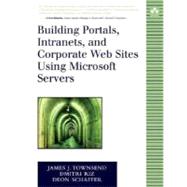
| Introduction To Portals | |
| Rise of the Portal | |
| Portal Definitions | |
| Types of Portals | |
| Benefits of Portals | |
| Attributes of Portals | |
| Summary | |
| Portal Elements | |
| Look and Feel | |
| Security | |
| User Profile | |
| Personalization | |
| Taxonomy | |
| Application Integration | |
| Database and Other Repositories | |
| Support for Transactions | |
| Collaboration Tools | |
| Multichannel support | |
| Search Engine | |
| Portal Solution Requirements Table | |
| Putting the | |
| NET Portal Together | |
| Microsoft's Portal Strategy | |
| The Microsoft Portal Perspective | |
| Microsoft Office Group | |
| Microsoft Enterprise Software Group | |
| Microsoft Online Properties | |
| Fundamental Portal Elements | |
| Optional Portal Elements | |
| Third Party Portal Elements | |
| Future Evolution of Portal Platform to Juniper and Beyond | |
| Migration of Server Products to .NET | |
| Conclusion: A Two-Pronged Portal Effect | |
| Web Services | |
| Introduction | |
| What Was Life Like Before Web Services? | |
| Current Technologies | |
| What Are Web Services? | |
| When Does It Make Sense to Develop/Deploy a Web Service? | |
| How Do Web Services Fit Into the Portal? | |
| Sample Web Service | |
| Web Service Benefits | |
| Conclusion | |
| Portal Framework-.Net | |
| Introduction | |
| The .NET Fundamentals | |
| Building Blocks of the .NET Framework..NET versus Other Applications | |
| The Portal Architecture | |
| The Portal Framework | |
| Conclusion | |
| Security Services | |
| Common Security Issues | |
| Building Blocks of Secure Application | |
| Authentication and Authorization Flow | |
| IIS Authentication Methods.ASP .NET Authentication Methods.Web Services Authentication.ASP .NET Process Identity | |
| Code Access Security and .NET Framework | |
| Microsoft SQL Server Security | |
| Microsoft Internet Security and Acceleration (ISA) Server 2000 | |
| Desigining a Security Strategy | |
| Security Model Changes in Windows Server 2000 | |
| Example: Securing an Intranet or Extranet Portal | |
| Summary | |
| User Profiles | |
| Identifying Key User Groups | |
| Registration Methods | |
| Creating User Profiles with Self Registration | |
| Self Registration with Commerce Server 2002 | |
| Profile Information | |
| Administering the Profile | |
| Tracking Anonymous Users | |
| Defining SPS Profiles | |
| SharePoint Audiences | |
| SharePoint Single Sign-On | |
| Analyzing Profile and Data | |
| Personalization | |
| The Personalization Cycle | |
| Creating Content for Personalization | |
| Personalizing Homepage Content | |
| Subscriptions, Notifications and Alerts | |
| Advertising Based on Profiles | |
| Getting More Out of Personalization | |
| Content Management | |
| Measuring Return on Investment for Content Management | |
| Content Management Options | |
| Site Framework For Content Management | |
| Content Management Server Overview | |
| Site Framework for Content Management Server | |
| Sharing the Portal Site in MCMS | |
| Creating Templates | |
| Content Creation and Approval Process | |
| Defining Channels | |
| Multilingual Sites | |
| Web Page Workflow Implementation | |
| Enabling Security on MCMS..NET and Web Services Integration | |
| Content Management in SharePoint | |
| Integrating SharePoint with Microsoft Content Management Server | |
| Custom Content Management | |
| Conclusion | |
| Developing Portal Taxonomy | |
| What Is Taxonomy?Taxonomy Concepts | |
| Sample Taxonomy | |
| Taxonomy Best Practices | |
| Taxonomy Implementation | |
| Ways to Instantiate Taxonomies | |
| Business Value of the Taxonomy | |
| Integrating Line Of Business Applications | |
| Integration Concepts | |
| Providing Intelligent Forms | |
| SharePoint Portal Server and EAI | |
| Integration with Custom Code | |
| BizTalk Concepts | |
| BizTalk Components | |
| Accelerators and Third Party Tools | |
| Benefits of Business Integration | |
| Conclusion | |
| Collaboration In The Enterprise Portal | |
| Collaboration Checklist | |
| The Human Side of Collaboration | |
| SharePoint Version 2 Paradigm | |
| Windows SharePoint Services and SharePoint Portal Server | |
| Creating a Basic Collaboration Site | |
| Creating a Discussion Board | |
| Document Management | |
| Project Teams | |
| Enabling Self-Service Site Creation | |
| Online Conferencing | |
| Understanding Web Parts | |
| Integrating SharePoint Portal Server with Content Management Server | |
| Additional Resources | |
| Search Engine | |
| Introduction | |
| Search Concepts | |
| Microsoft Indexing Service | |
| Managing Search Settings in SharePoint Portal Server | |
| Managing Search Schedul | |
| Table of Contents provided by Publisher. All Rights Reserved. |
The New copy of this book will include any supplemental materials advertised. Please check the title of the book to determine if it should include any access cards, study guides, lab manuals, CDs, etc.
The Used, Rental and eBook copies of this book are not guaranteed to include any supplemental materials. Typically, only the book itself is included. This is true even if the title states it includes any access cards, study guides, lab manuals, CDs, etc.